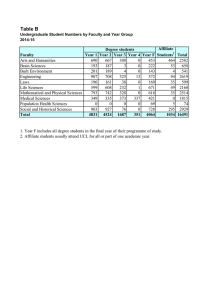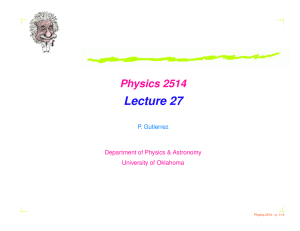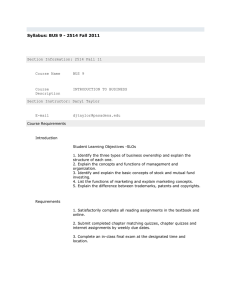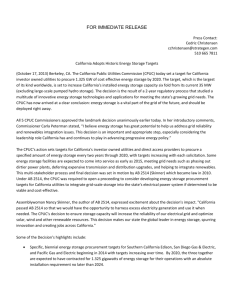Physics 2514 Lecture 20 - The University of Oklahoma Department
advertisement
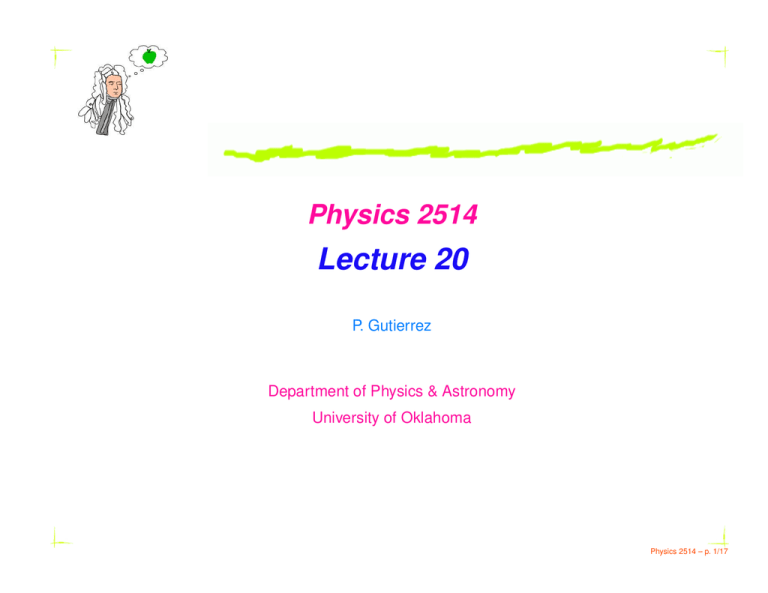
Physics 2514 Lecture 20 P. Gutierrez Department of Physics & Astronomy University of Oklahoma Physics 2514 – p. 1/17 Goals Start the discussion of circular motion. We will apply Newton’s second law to circular motion. Physics 2514 – p. 2/17 Circular Motion Physics 2514 – p. 3/17 Review Kinematic equations and variables for circular motion Motion along arc is 1-D with tangential acceleration and velocity specifying motion s = s0 + vot t + 1 at t 2 2 vt = v0t + at t Now in terms of angular variables θ = θ 0 + ω0 t + ω = ω0 + αt Centripetal acceleration v2 ar = r 1 2 αt 2 s r at α= r θ= ω= vt r Physics 2514 – p. 4/17 Example 1 A 5.0 m diameter merry-go-round is initially turning with a 4.0 s period. It slows down and stops in 20 s. How many revolutions does it make as it slows down? Use angular variables Known: s ag replacements θ r T = 4 s ⇒ ω0 = 2π/T = 1.57 rad/s t = 20 s ⇒ ωf = 0 Unknown: No. of revolutions α=? ωf = ω0 + αt ⇒ α = −0.0785 rad/s2 θ − θ0 = ω0 t + 12 αt2 ⇒ ∆θ = 15.7 rad ⇒ ∆θ 2π = 2.5 rev Physics 2514 – p. 5/17 Example 1 A 5.0 m diameter merry-go-round is initially turning with a 4.0 s period. It slows down and stops in 20 s. How many revolutions does it make as it slows down? Use linear variables (arc-length) Known: s ag replacements θ r T = 4 s ⇒ vt0 = 2πr/T = 3.93 m/s t = 20 s ⇒ vtf = 0 Unknown: No. of revolutions at = ? vtf = vf 0 + at t ⇒ at = −0.196 m/s2 s − s0 = vt0 t + 12 at t2 ⇒ ∆s = 39.4 m ⇒ ∆s 2πr = 2.5 rev Physics 2514 – p. 6/17 Example 2 A car drives over the top of a hill that has a radius of 50 m. What maximum speed can the car have without flying off the road at the top of the hill? replacements r Apply Newton’s second law Known r = 50 cm n=0 r Unknown vt vt2 √ mg − n = m ⇒ vt = gr ≈ 22 m/s r Physics 2514 – p. 7/17 Clicker A 75 kg man weights himself at the north pole and at the equator. Which scale reading is greater? 1. north pole; 2. Equator; 3. Both are equal. Physics 2514 – p. 8/17 Blank Physics 2514 – p. 9/17 Solution A 75 kg man weights himself at the north pole and at the equator. How much lighter is his apparent weight at the equator? North pole v = 0 (v = Rω, R = 0) mg − n = 0 apparent weight = n = mg PSfrag replacements ⇒ Equator ω = 2π T North Pole n = 7.3 × 10−5 rad/s v2 = mRω 2 mg − n = m R ⇒ apparent weight = n = mg−mRω 2 r mg equator mg n r Difference is mRω 2 = 2.5 N or ≈ 1/2 lb lighter at the equator. R = 6.37 × 106 m Physics 2514 – p. 10/17 Clicker An object attached to a string is whirled in a circle of radius r in the horizontal plane. In addition, the speed of the object is constant. What is the cause of the outward force acting on the object that keeps the string stretched? 1. Centrifugal force; 2. Inertial force; 3. There is no outward force; 4. Gravity; 5. My hand whirling it. Physics 2514 – p. 11/17 Blank Physics 2514 – p. 12/17 Solution There is no outward force. According to Newton’s first law the object wants to continue in a straight line, therefore the tension in the string is pulling it inward from the path it wants to take. v2 T =m r T PSfrag replacements Physics 2514 – p. 13/17 Example 3 Consider a roller coaster, what is the apparent weight of a passenger of mass m at the top and bottom of the of the path? The speed at the top is vt , at the bottom it is vb . At the top Forces in radial direction vt2 n + mg = m r ⇒ vt2 n=m − mg r Physics 2514 – p. 14/17 Example 3 Consider a roller coaster, what is the apparent weight of a passenger of mass m at the top and bottom of the of the path? The speed at the top is vt , at the bottom it is vb . At the bottom Forces in radial direction n − mg = m vb2 r ⇒ n=m vb2 r + mg Physics 2514 – p. 15/17 Clicker An object follows a circular trajectory at a constant speed. At the location shown on the figure, which force diagram (free-body diagram) describes the system. Assume that there is no friction g replacements a b y g x c d Physics 2514 – p. 16/17 Assignment Start reading Chapter 8 Physics 2514 – p. 17/17
